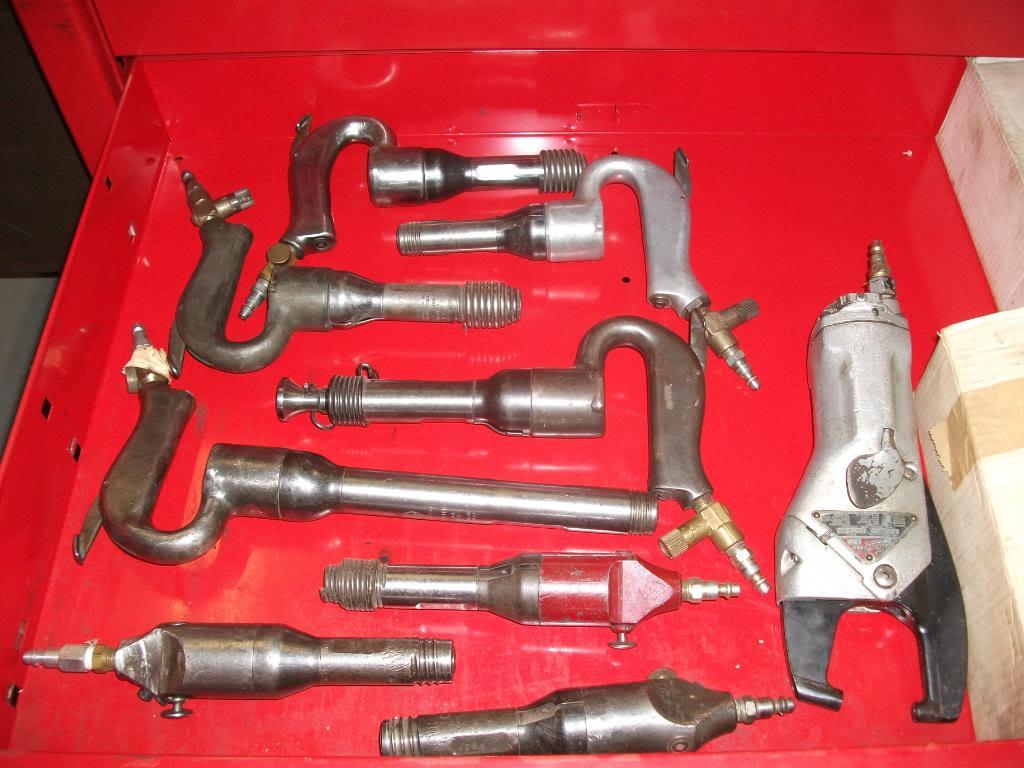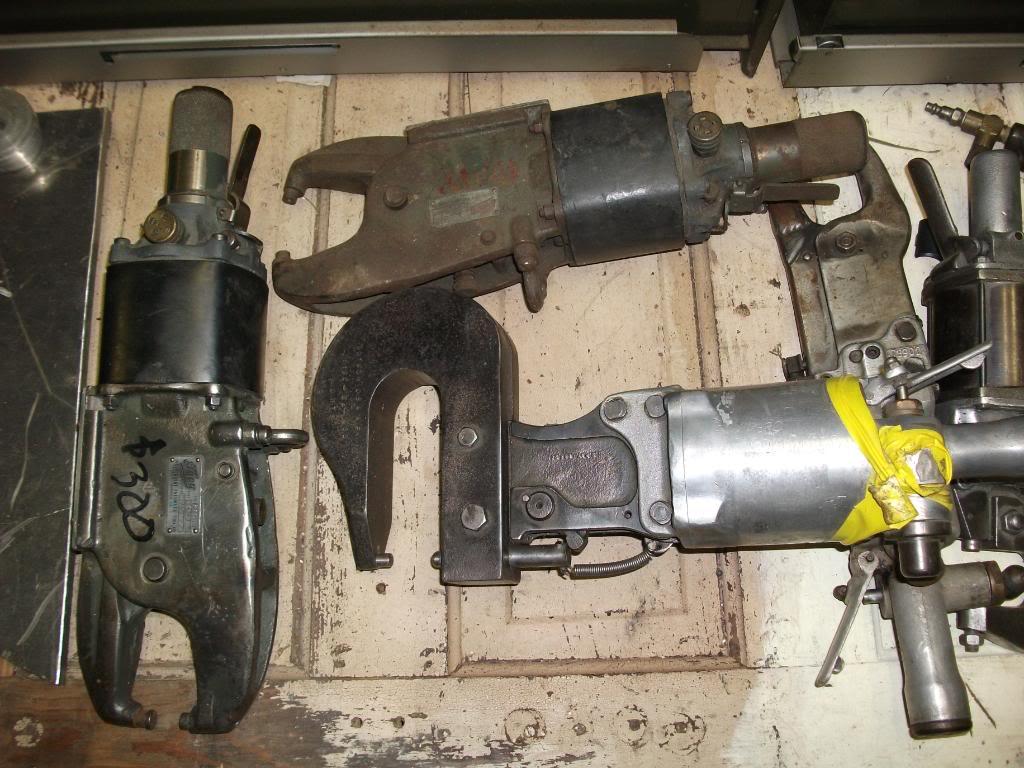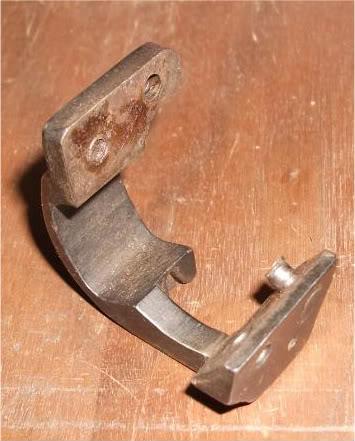-
I'm going with "rivets" in this case. Not that I'm a full time riveter, anymore. Nor employed as a welder. But...
BTW, SMLE charger bridges are riveted assemblies. They look about the same when cut off nicely. Not so much when wrenched away!( would have more photos, but P'bucket is hardly working. Took about 20 minutes just to get to the tools album!)


Have a few 1888s and never thought the added charger guides were anything but riveted! But there may very well be welded examples out there as well.
---------- Post added at 11:27 AM ---------- Previous post was at 11:23 AM ----------
And what's with the crazy rectangular cutout on the left receiver wall just forward of the bolt stop?
Last edited by jmoore; 01-31-2016 at 11:34 AM.
-
Thank You to jmoore For This Useful Post:
-
01-31-2016 11:27 AM
# ADS
Friends and Sponsors

-
Legacy Member


Originally Posted by
jmoore

I'm going with "rivets" in this case. Not that I'm a full time riveter, anymore. Nor employed as a welder. But...
BTW, SMLE charger bridges are riveted assemblies. They look about the same when cut off nicely. Not so much when wrenched away!( would have more photos, but P'bucket is hardly working. Took about 20 minutes just to get to the tools album!)
https://www.milsurps.com/images/impo...stuff089-1.jpg
https://www.milsurps.com/images/impo...stuff023-1.jpg
Have a few 1888s and never thought the added charger guides were anything but riveted! But there may very well be welded examples out there as well.
---------- Post added at 11:27 AM ---------- Previous post was at 11:23 AM ----------
And what's with the crazy rectangular cutout on the left receiver wall just forward of the bolt stop?
The cut out is what positioned the guides before they were welded . Explain how a rivet works in a blind hole .
-
-
Contributing Member


Just to clear things up a bit, the "ears" on the 88/05 are RIVETED. This is well documented and for anyone who questions this I refer you to "A Collectors Guide to the German Gew. 88 "Commission" Rifle page 105. There is a later modification called the 88/14, which this particular rifle clearly is not, which had a different type of ear welded and shaped onto the receiver. These examples are now quite rare as it is suspected most were destroyed after WWII as part of the Treaty of Versaille. This modification was not one which was given to the Turks.
Gew. 88 "Commission" Rifle page 105. There is a later modification called the 88/14, which this particular rifle clearly is not, which had a different type of ear welded and shaped onto the receiver. These examples are now quite rare as it is suspected most were destroyed after WWII as part of the Treaty of Versaille. This modification was not one which was given to the Turks.
The "crazy rectangular cutout" is where the forward portion of the left side guide fits. For strength purposes of the guide, they cut it out rather than try to form it along the round surface. As the right side has no "height" to it, there is no need for a cutout of any type on the right.
Now I admit, I am one who is more apt to believe a book written by an expert who has researched these rifles over a period of years collaborating with many other knowledgeable people than one individual on the internet that messed with one so take this information as you will. It is however backed up by numerous sources on the internet for anyone who cares to believe such sources.
As for who removed them. It was not the Germans. There would be no reason for the Turks to have done so unless one of the ears was broken off and they had no means to repair it. This being the same for a post Turk owner.
The book is great by the way. Highly recommend it. Lots of information in there on how the rifles came about, all modifications done to them, the copycats, etc and at the end firing data comparing them to other similar rilfes. Tons of period photos.
Last edited by Aragorn243; 01-31-2016 at 01:37 PM.
-
The Following 3 Members Say Thank You to Aragorn243 For This Useful Post:
-
Legacy Member



Originally Posted by
bob q

The cut out is what positioned the guides before they were welded
As I understand it the milled slot was part of the magazine modification. It was done to allow the fitting of a cartridge retainer since the 88/05 upgrade no longer relied on an the bloc clip to hold the rounds in the magazine. Never came across any info that mentioned it being for charger guide location purposes.

Originally Posted by
bob q

Explain how a rivet works in a blind hole .
Why don't you tell us, seems you have all the answers.
Last edited by vintage hunter; 01-31-2016 at 03:19 PM.
-
Thank You to vintage hunter For This Useful Post:
-
Legacy Member


Originally Posted by
Aragorn243

The book is great by the way. Highly recommend it. Lots of information in there on how the rifles came about, all modifications done to them, the copycats, etc and at the end firing data comparing them to other similar rilfes. Tons of period photos.
The book is already on the way and should be in on Tuesday or Wednesday along with my Mannlicher Military Rifles book. Should be a good go, I've been wanting those books for a while and finally broke down and got them.
-
-
Legacy Member


Originally Posted by
vintage hunter

As I understand it the milled slot was part of the magazine modification. It was done to allow the fitting of a cartridge retainer since the 88/05 upgrade no longer relied on an the bloc clip to hold the rounds in the magazine. Never came across any info that mentioned it being for charger guide location purposes. We are talking about a different cut .
Why don't you tell us, seems you have all the answers.
You missed the point . It can not be done . There is NO through hole , so it can not be a rivet .
---------- Post added at 07:50 PM ---------- Previous post was at 07:42 PM ----------

Originally Posted by
Aragorn243

Just to clear things up a bit, the "ears" on the 88/05 are RIVETED. This is well documented and for anyone who questions this I refer you to "A Collectors Guide to the
German
Gew. 88 "Commission" Rifle page 105. There is a later modification called the 88/14, which this particular rifle clearly is not, which had a different type of ear welded and shaped onto the receiver. These examples are now quite rare as it is suspected most were destroyed after WWII as part of the Treaty of Versaille. This modification was not one which was given to the Turks.
The "crazy rectangular cutout" is where the forward portion of the left side guide fits. For strength purposes of the guide, they cut it out rather than try to form it along the round surface. As the right side has no "height" to it, there is no need for a cutout of any type on the right.
Now I admit, I am one who is more apt to believe a book written by an expert who has researched these rifles over a period of years collaborating with many other knowledgeable people than one individual on the internet that messed with one so take this information as you will. It is however backed up by numerous sources on the internet for anyone who cares to believe such sources.
As for who removed them. It was not the Germans. There would be no reason for the Turks to have done so unless one of the ears was broken off and they had no means to repair it. This being the same for a post Turk owner.
The book is great by the way. Highly recommend it. Lots of information in there on how the rifles came about, all modifications done to them, the copycats, etc and at the end firing data comparing them to other similar rilfes. Tons of period photos.
It is not well documented . It is his opinion , done with no research other than using second hand internet info . He does not read German , he did not look at any original German documents . He owns no rifles . He is not an expert . There is a lot of incorrect information in his book . You are saying he is right , BUT all the original German military document are wrong ? He and his friends are the main source of all the incorrect information out there about Gew-88 rifles . I am amazed that the truth about the rivet is right in front of you and you can not see it .
-
-
Legacy Member



Originally Posted by
bob q

We are talking about a different cut .
Yes, you're right. My mistake.

Originally Posted by
bob q

Explain how a rivet works in a blind hole .
While I have no direct knowledge on or experience in how rivets might work in a blind hole I do have a theory. The rivet is ''headless'' and the hole(s) in the part being attached would have to be countersunk. As the rivet was set the(possibly heated) portion inside the blind hole would expand tightly against the sides of the hole before the upper part upset enough to form a shop head in the countersunk holes of the part being attached. Again this is just a theory, but the attached photo's of Lee Enfield No.4&5 charger bridge rivets seem to support it. Photo's are of 3 rifles are from 3 different makers, 2 show through holes in the action body directly under the bridge on the right side but none show any signs whatsoever of holes on the left side. So, it would appear that rivets can be used in blind holes

Originally Posted by
bob q

It is not well documented . It is his opinion , done with no research other than using second hand internet info . He does not read
German
, he did not look at any original German documents . He owns no rifles . He is not an expert . There is a lot of incorrect information in his book . You are saying he is right , BUT all the original German military document are wrong ? He and his friends are the main source of all the incorrect information out there about Gew-88 rifles
If all this is true and you have the necessary documentation to prove it why not write your own book and set the record straight.

Originally Posted by
bob q

the original German military document
In the mean time while we're waiting for the book to come out how about provide a link to the above mentioned document detailing the charger guide attachment method, or better yet post a copy here. We'd all love to see it.
-
Thank You to vintage hunter For This Useful Post:
-
Contributing Member



Originally Posted by
bob q

I am amazed that the truth about the rivet is right in front of you and you can not see it .
Oh, I can see the truth just fine. It's on page 105. I can see the truth in the words of very experienced people who I know and trust. A few of these people are retired armorers for their nations military and they fixed and rebuilt these things for years. So yes, not too difficult to discern the truth here.
"In the mean time while we're waiting for the book to come out how about provide a link to the above mentioned document detailing the charger guide attachment method, or better yet post a copy here. We'd all love to see it."
I wouldn't hold my breath. Still waiting for similar Italian documents on the other thread.
documents on the other thread.
Last edited by Aragorn243; 01-31-2016 at 09:36 PM.
-
-
Legacy Member

-
Thank You to WarPig1976 For This Useful Post:
-

Originally Posted by
vintage hunter

In the mean time while we're waiting for the book to come out how about provide a link to the above mentioned document detailing the charger guide attachment method, or better yet post a copy here. We'd all love to see it.
Here's a photo I found of a brutally removed SMLE charger bridge in my collection:

Note the barely flared end of the rivet pulled from the action body. Would be about invisible...
Generally, on most SMLEs the heads and tails have been linished off so well you can't see the rivets at all. No.4 charger bridge rivets (if installed, i.e. those Fazackerly welded bridges which never had rivets) usually are easier to detect.
All this weighed on my mind so much I plumb forgot to look at my various 1888s with the added guides. Only photos I have are of the non-modded version. MAYBE, if I remember all the folderol we'll have more pictures this week.
Last edited by jmoore; 02-01-2016 at 03:00 AM.
-
Thank You to jmoore For This Useful Post:



















 PM
PM










